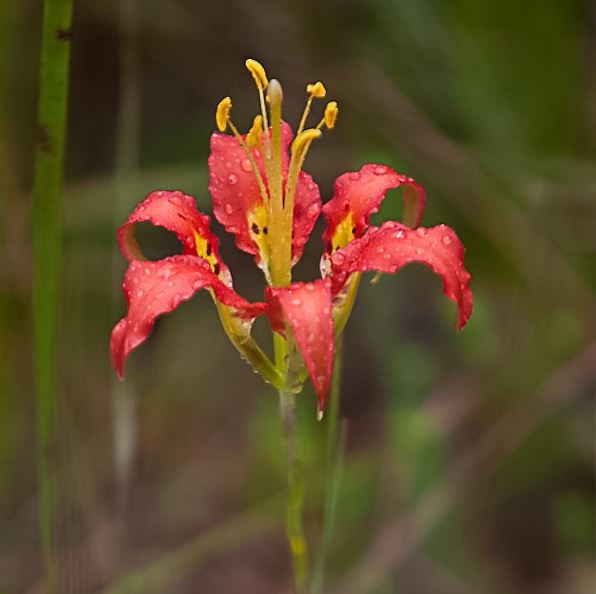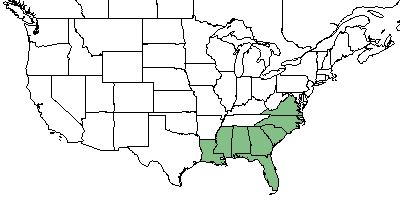Difference between revisions of "Lilium catesbaei"
(→Ecology) |
(→Ecology) |
||
| Line 32: | Line 32: | ||
==Ecology== | ==Ecology== | ||
===Habitat=== <!--Natural communities, human disturbed habitats, topography, hydrology, soils, light, fire regime requirements for removal of competition, etc.--> | ===Habitat=== <!--Natural communities, human disturbed habitats, topography, hydrology, soils, light, fire regime requirements for removal of competition, etc.--> | ||
| − | ''L. catesbaei'' proliferate in pine savannas and sandhill seeps. <ref name= "Weakley 2015"> Weakley, A. S. (2015). Flora of the Southern and Mid-Atlantic States. Chapel Hill, NC, University of North Carolina Herbarium. </ref> | + | ''L. catesbaei'' proliferate in pine savannas and sandhill seeps. <ref name= "Weakley 2015"> Weakley, A. S. (2015). Flora of the Southern and Mid-Atlantic States. Chapel Hill, NC, University of North Carolina Herbarium. </ref> Specimens have been collected from moist sandy soil with wiregrass, sandy peat of savanna, pine flatwoods, cypress pond slash pine, open long leaf pine stand, pine savanna, and roadsides.<ref name = "FSU herbarium"> URL: http://herbarium.bio.fsu.edu. Last accessed: June 2018. Collectors: Daniel B. Ward, S.S. Ward, Lovette E. Williams, Robert Bral, Olga Lakeela, R.K. Godfrey, Robert Lazor, John Lazor, Bruce Hansen, S.W. Leonard, D.L. Fichtner, Paul Redfearn, D.S. Correll, Paul O. Schallert, Cecil Slaughter, Jennifer Hancock, Wilson Baker, Grady W. Reinert, R.A. Norris, R. Komarek, R.L. Wilbur, Rodie White, S.B. Jones, Carleen Jones, John W. Carter, S.L. Orzell, P. SHeridan. States and counties:Florida (Alachua, Bay, Charlotte, Citrus, Escambia, Gulf, Highlands, hillsborough, Jackson, Liberty, Orange, Palm Beach, St. Johns, Union, Wakulla, Walton, Okaloosa, Nassau, Flagler, Osceola) Georgia (Coffee, Worth, Charlton, Grady, Thomas) North Carolina (Columbus, Pender, Bladen) Alabama (Mobile) Mississippi (Forrest) South Carolina (Corchester)</ref> |
===Phenology=== <!--Timing off flowering, fruiting, seed dispersal, and environmental triggers. Cite PanFlora website if appropriate: http://www.gilnelson.com/PanFlora/ --> | ===Phenology=== <!--Timing off flowering, fruiting, seed dispersal, and environmental triggers. Cite PanFlora website if appropriate: http://www.gilnelson.com/PanFlora/ --> | ||
''L. catesbaei'' flowers June-October. <ref name= "PanFlora"> PanFlora Author: Gil Nelson URL: [http://www.gilnelson.com/PanFlora/ http://www.gilnelson.com/PanFlora/] Date Accessed: 5/24/18 </ref> | ''L. catesbaei'' flowers June-October. <ref name= "PanFlora"> PanFlora Author: Gil Nelson URL: [http://www.gilnelson.com/PanFlora/ http://www.gilnelson.com/PanFlora/] Date Accessed: 5/24/18 </ref> | ||
Revision as of 10:21, 26 June 2018
Common name: pine lily [1], Catesby's lily [2], leopard lily [2]
| Lilium catesbaei | |
|---|---|

| |
| Photo by John B | |
| Scientific classification | |
| Kingdom: | Plantae |
| Division: | Magnoliophyta - Flowering plants |
| Class: | Magnoliopsida - Dicots |
| Order: | Liliales |
| Family: | Liliaceae |
| Genus: | Lilium |
| Species: | L. catesbaei |
| Binomial name | |
| Lilium catesbaei Walter | |

| |
| Natural range of Lilium catesbaei from USDA NRCS Plants Database. | |
Contents
Taxonomic Notes
Synonyms: none
Varieties: none
Description
L. catesbaei is a perennial forb/herb of the Liliaceae family native to North America. [1]
Distribution
L. catesbaei is found along the southeastern coast of the United States from Louisiana to Virginia. [1]
Ecology
Habitat
L. catesbaei proliferate in pine savannas and sandhill seeps. [2] Specimens have been collected from moist sandy soil with wiregrass, sandy peat of savanna, pine flatwoods, cypress pond slash pine, open long leaf pine stand, pine savanna, and roadsides.[3]
Phenology
L. catesbaei flowers June-October. [4]
Fire ecology
L. catesbaei flowers more conspicuously following fire. [5]
Conservation and Management
L. catesbaei is listed as threatened by the Florida Department of Agriculture & Consumer Services Division of Plant Industry. [1]
Cultivation and restoration
Photo Gallery
References and notes
- ↑ 1.0 1.1 1.2 1.3 USDA Plant Database https://plants.usda.gov/core/profile?symbol=LICA4
- ↑ 2.0 2.1 2.2 Weakley, A. S. (2015). Flora of the Southern and Mid-Atlantic States. Chapel Hill, NC, University of North Carolina Herbarium.
- ↑ URL: http://herbarium.bio.fsu.edu. Last accessed: June 2018. Collectors: Daniel B. Ward, S.S. Ward, Lovette E. Williams, Robert Bral, Olga Lakeela, R.K. Godfrey, Robert Lazor, John Lazor, Bruce Hansen, S.W. Leonard, D.L. Fichtner, Paul Redfearn, D.S. Correll, Paul O. Schallert, Cecil Slaughter, Jennifer Hancock, Wilson Baker, Grady W. Reinert, R.A. Norris, R. Komarek, R.L. Wilbur, Rodie White, S.B. Jones, Carleen Jones, John W. Carter, S.L. Orzell, P. SHeridan. States and counties:Florida (Alachua, Bay, Charlotte, Citrus, Escambia, Gulf, Highlands, hillsborough, Jackson, Liberty, Orange, Palm Beach, St. Johns, Union, Wakulla, Walton, Okaloosa, Nassau, Flagler, Osceola) Georgia (Coffee, Worth, Charlton, Grady, Thomas) North Carolina (Columbus, Pender, Bladen) Alabama (Mobile) Mississippi (Forrest) South Carolina (Corchester)
- ↑ PanFlora Author: Gil Nelson URL: http://www.gilnelson.com/PanFlora/ Date Accessed: 5/24/18
- ↑ Abrahamson, W. G. (1984). "Species Responses to Fire on the Florida Lake Wales Ridge." American Journal of Botany 71(1): 35-43.